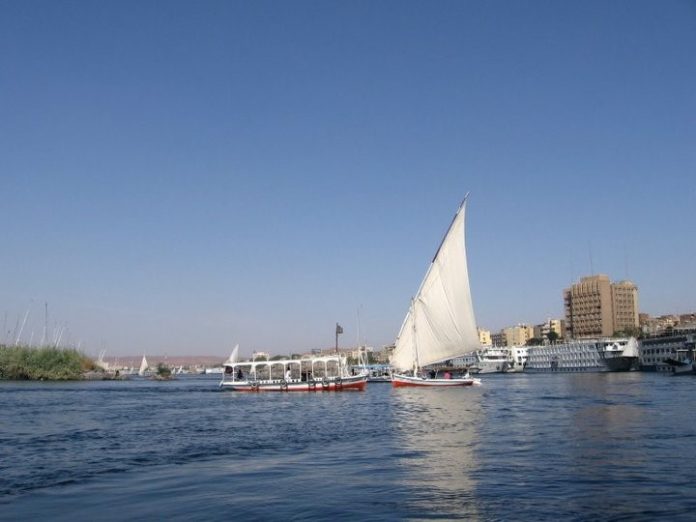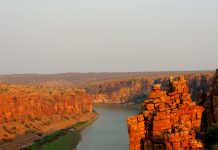Ships and boats ready for tourists on the Nile
The Ha-Shihor (in Biblical Hebrew), Nilus (in Latin), en-Nil (in Arabic), or the Nile (in plain English), as it is commonly known, breathes life into the ancient land of Egypt. The Nile river cruise is a popular journey taken upstream from Luxor to Aswan, a distance of 181 kilometres. It is covered over four nights and five days, with well-planned halts at some of the great archaeological sites.
I boarded the M/S Sindbad with my family at Luxor, having flown down from Cairo. We were greeted by courteous cruise staff that showed us to our cabins, dropped off our bags, and handed us the tentative cruise itinerary.
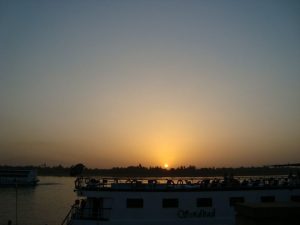
M/S Sindbad at sunset
Day 1: With bags stowed away in the cabins, the guests gathered at the top deck for an introductory session. Here we were given safety guidelines and the captain of the ship explained the importance of being on time. After this introductory session, we were introduced to our tour guide who would chaperon our visits to various sites over the next few days.
The dining hall awaited the guests for lunch. The lunch was mostly Middle Eastern cuisine – juicy chicken, scrumptious exotic meats, and locally caught fish were prepared in various ways. Apart from being a meat lover’s dream spread, there were enough vegetarian preparations to satisfy the herbivorous types. Guests were welcomed to eat their fill. But given the fact that we had to start our tour post lunch, we ate modest amounts.
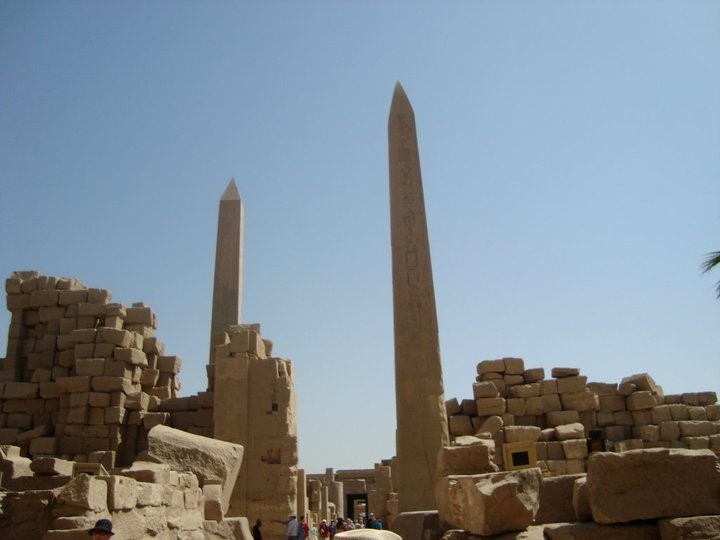
Obelisks at Karnak
Sphinx at Karnak temple
Our first stop was the UNESCO world heritage site of Karnak temple. An open museum welcomed visitors at the sprawling Karnak temple complex. Temple complexes dedicated to various middle kingdom Gods make up the Karnak complex. Yet, it is only the Amun precinct that is open to visitors. An impressive architectural marvel is an optical illusion created by two obelisks that appear to be of the same height while one is indeed shorter than the other. The Karnak temple complex visit is incomplete without the Luxor temple tour.
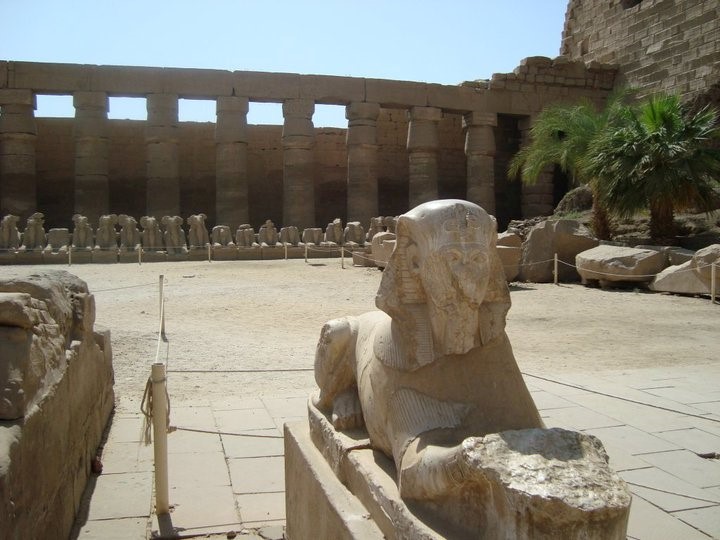
Sphinx at Luxor
From Karnak, we went to the Luxor temple complex. The ancient Theban temple complex has multiple well-preserved mortuary temples. Nubian sandstone, carried from Gebel el-Silsila region, were used to build the marvellous structures that have been excavated since 1884. The Theban cult festival, Opet festival, was centred around the Luxor temple. The statue of Amun has been carried down a path, flanked by Sphinx statues, all the way from the Karnak temple to the Luxor temple. Parts of the path and some of the Sphinx remain as a testament to the grand annual festival.

Remaining obelisk at Luxor
Just like the Karnak temple, the Luxor temple too had optical illusions created by obelisks, but the French took one of the obelisks that can now be seen in Palace-de-la-Concorde. If the architectural marvels were not enough to awe the visitors, the Luxor light show pulls all the stops. The one-and-a-half hour long stunning show retells the history of Theban, which revolves around Amun.
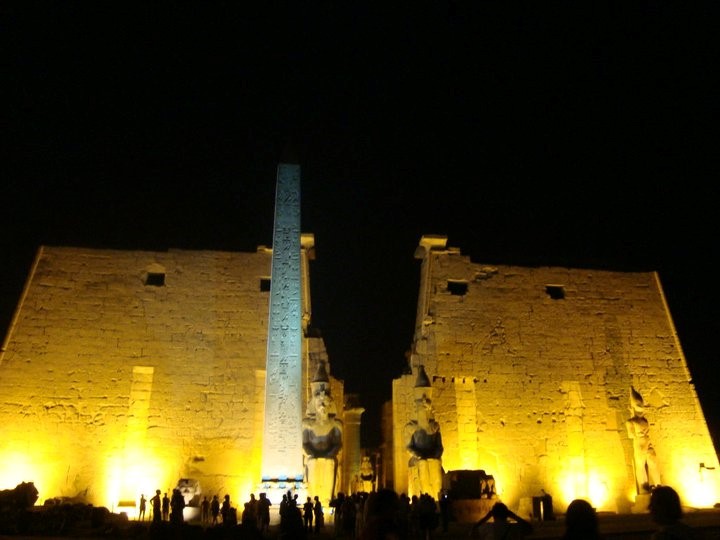
On our return to the ship, we had time to change and enjoy a large buffet spread for dinner. Though most of the guests were from different parts of the world, the day’s experiences gave us all a chance to start a conversation.
Day 2: Having spent the night onboard the ship, which was still docked at Luxor, we woke up to an early breakfast spread. A live counter prepared eggs, according to the guests’ preference. The breakfast buffet had everything from all the components of a quintessential English breakfast (baked beans, sausage, grilled tomatoes, toast, and sautéed mushrooms), including a selection of cornflakes.
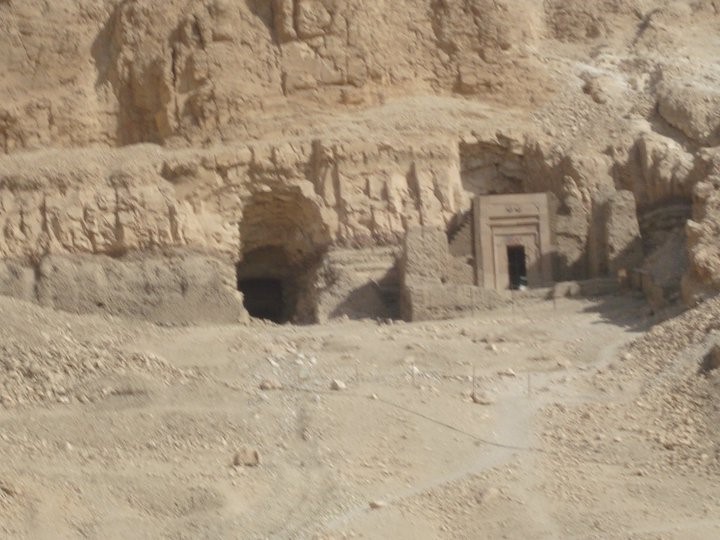
Entrance to tombs at Valley of the Kings
The first and the most extended stop of the day was at the Valley of the Kings. While pyramids are what most people know Egypt for, most Egyptian royalties did not have their tombs in pyramids. You can find the tombs of most famous Egyptian Pharaohs in the Valley of the Kings.
The most famous one in the valley is that of King Tut. To enter the elusive tomb of King Tutankhamun, you have to buy entry tickets separately. Some of the tombs have free entry. There is a perennial line of tourists trying to enter the tomb of King Tut. However, on entering we found that there was very little to see in the tomb since it was almost entirely empty.
All the tombs are uniformly structured. You have to walk down the dimly-lit passage to the main burial chamber where the sarcophagus used to be kept. The passage walls are decorated with colourful images that narrate stories of the Pharaohs and gods. At the end of the passage are large empty chambers, as most of the buried items there have been sold or displayed at museums around the world.
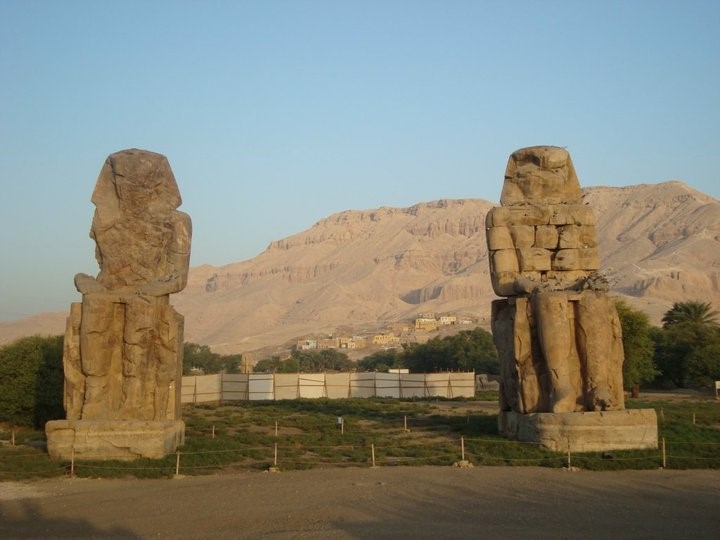
Statues of Pharaoh Amenhotep III at Colossi of Memnon
The second stop for the day was the Colossi of Memnon, which are two gigantic statues dedicated to the Pharaoh Amenhotep III. The site is less crowded. Since there is not much to see, this stop was a very short one, where the guide talked about Pharaoh Amenhotep III, while the tourists hastily clicked photos of the statues.
Mortuary temple of Hatshepsut
The final attraction in Luxor, as per the itinerary, was the Temple of Hatshepsut.
Temple of Hatshepsut is a unique temple structure to visit; it was a mortuary temple built to honour one of the few female Pharaohs – Hatshepsut. Apart from the temple itself, the surrounding hills showcase the excellence of Egyptian architecture. The cliffs had holes dug into them for labourers to stay while they built the temple. Visitors to the temple get a glimpse of how a woman in a powerful position affected the people. Large parts of the temple had been defaced by the oppositions of Hatshepsut, after her death. Even her mummy had not been spared the wrath of the objectors who had broken into her tomb and vandalised her body. Yet, Hatshepsut’s temple remains a testament to hardship that women can face and overcome.
Entrance to Edfu Temple
The Boat of Horus
Our days at Luxor came to an end as we set sail for Edfu.
Edfu has the Edfu temple complex, which is dedicated to Horus, the falcon-faced primary Egyptian god. The Edfu temple is a well-preserved site with the walls holding volumes of historical records. A must-see relic at Edfu is the boat of Horus. It is a kind of palanquin used to carry the idol of Horus that was taken to the temple of Hathor.
The Edfu temple is the last stop for the day. As night approached, our ship docked at Kom Ombo.
Day 3: The Kom Ombo temple complex is the only experience for the day for which we had to get off the boat.
The Kom Ombo temple complex is considered unique since it houses two identical temples dedicated to two sets of gods. Much of the Ptolemaic temple complex lay in ruins due to the flooding caused by the Nile and earthquakes at various points. Yet, visitors can wander around the temple complex and soak in the architectural brilliance that was involved in creating two symmetrical temples.
View of the Nile while sailing
Playing table tennis for recreation
We had some time to relax and enjoy the cruise for the rest of the day. One can enjoy the green landscape that flanks the river. Playing table tennis and socializing with the staff and other guests occupied the rest of the day. Most of the cruises come with a pool, gaming tables, and recreational activities that guests can enjoy. Relaxation was the theme of the third day.
Guests gathered on the top deck to experience the passage through the Esna Lock. One could even take a seat at the front of the ship to see it manoeuvre into the lock. The gates allowed the water level of the lock to raise enough for the ship to cross over to the Aswan part of the Nile. We could see the whole process from the top deck.
Day 4: The final day had a packed itinerary. A visit to the Aswan high dam started the day. At a height of 111 meters, the High Dam plays a key role in flood management and irrigation for Egypt. The dam stands as a testament to the fact that scientific ingenuity is not limited to only ancient Egyptians.
The Unfinished Obelisk is another proof of exceptional Egyptian craftsmanship. One can visit the site of this obelisk and see excavated remains of what Hatshepsut had planned as the largest obelisk in Egypt (her death left the project unfinished).
Ruins at the temple of Philae
The final temple on the itinerary was the Philae temple – dedicated to Isis, a primary mother goddess. A unique aspect of this temple is that it was earlier located in Upper Egypt, where floods took a toll on the structures; following this, UNESCO moved the entire temple to its current location. The entire temple was dismantled and reassembled like a complex Lego structure.
View of surrounding ruins during the Felucca ride
The final tour experience is an optional one – a felucca ride on the Nile. You can speed up and down the Nile and spot some ruins flanking the river during the ride. The large sail of the felucca allows the vessel to move quite fast, making the ride a short one.
Nubian nights party
After the felucca ride, guests were free to explore the streets of Aswan. Near the docks, one can find restaurants and shops. From pizzas to shawarmas, there are many delicacies to suit different tastes at the restaurants.
I would like to caution tourists here though. As we realized, some restaurants do not display prices on their menus at all and present an exorbitant bill at the end of the meal. In order to avoid paying a higher price at the end of the meal, it is advisable to choose restaurants that clearly display prices.
A “Nubian Nights” or “Egyptian Nights” theme party is organised as a farewell for the guests on the Nile cruise M/S Sindbad. With the evening free to head for the markets, the passengers of the ship headed off to buy traditional Egyptian costumes. If you plan on taking the cruise, carry accessories to help you dress up for the Nubian Nights party. Bargaining at the shops can help get a reduction and you can always buy a dress while there, but if you are a conscious spender, you could carry dresses and accessories in advance.
The article is contributed by Agrima Tikader, who is a happy, passionate, and frequent traveller to many places around the world. She aspires to do more of that and write about her experiences of travel and food, before going the Ruskin Bond route and retiring to the tranquillity of the hills.


